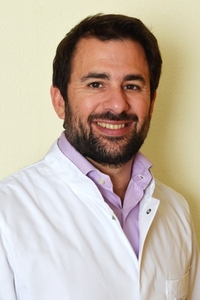

 FACULTATIVO ESPECIALISTA CIR. ORTOPÉDICA Y TRAUMATOLOGÍATraumatología y Cirugía OrtopédicaCentro Médico Teknonen/health-centers/centro-medico-teknon
FACULTATIVO ESPECIALISTA CIR. ORTOPÉDICA Y TRAUMATOLOGÍATraumatología y Cirugía OrtopédicaCentro Médico Teknonen/health-centers/centro-medico-teknon
Can you explain us more about the endoscopic spine surgery that you perform?
It is a novel treatment in spine surgery. It is a minimally invasive surgery in which, through a small skin incision of five millimeters in the posterior lateral part of the back or neck, an endoscope is introduced, which allows perfect vision of the internal structures with a video camera. The operation is performed under local anesthesia, there is no significant bleeding, and the patient usually returns home the next morning.
Why is the patient kept awake, isn’t it painful?
No, it is not, because the herniation itself does not hurt. The patient is operated awake to be sure that the disc we are touching is the one with the pathology. It doesn’t hurt thanks to the local anesthesia and the minimum invasion. Thus, when operating a herniated disc I can control any possible contact with a nervous structure and avoid its possible injury. Additionally, local anesthesia is a benefit for the patient’s recovery while it also avoids the risks of general anesthesia.
What is a herniated disk?
To explain it, we must understand how the spine works. An intervertebral disk is located between every two vertebral bodies and consists of an outer ring (annullus) and a soft core, the nucleus pulposus. The disk is compressed by the vertebrae when we stand up and walk. The disks allow the beding of the spine and absorb the body weight when we are standing. When a disk is damaged, the nucleus pulposus inside degenerates, begins to push onto the outer ring, which in turn is deformed. Then a bulge appears that may hurt. If the ring is completely broken, the core can be pushed outside of the ring and can compress the nerves that pass through that level of the spine. That is what we call a herniated disk.
When should a patient have surgery?
When the pain is recurrent in spite of the medication, if it lasts more than a month or if it is of the discogenic type (it hurts when standing or getting up). And, of course, if there is an irritation of the sciatic nerve (ciatalgia).
Is it also useful for low back pain?
Yes, traditional surgery does not treat low back pain, especially in early stages of disk degeneration. However, endoscopic surgery, as it is a minimally invasive surgery, it is possible to treat back pain even if there is no compression of any nerve structure.
The operation is performed with the same technique, decompressing the disc and repairing it with radiofrequency to eliminate the inflammation.
What are the advantages of endoscopic surgery compared to other techniques?
The laser and radiofrequency ablation allows the soft tissue to be easily and accurately be volatilized. It is fast and clean and it prevents that residual tissue may get infected or delay the healing of the disk.
As it is a minimally invasive technique, the patient recovers much faster. The skin wound is very small and there is no major bleeding and fibrosis.
What is the post-operative time until I am recovered?
It depends on the pathology that has been treated. However, the patient resumes walking the same day of the surgery. After four or five days he can usually return to his daily job ( as long as it does not imply heavy weight or load bearing).
Is it possible for the hernia to reproduce?
Unfortunately, this happen in a few cases, but it has nothing to do with the surgical technique. Any patient operated of an hernia has to follow a behavioral protocol of the spine andlearn how to bear weight to avoid a relapse of an herniation.
Is it an expensive treatment?
It depends on how you look at it. If you consider that there you will be few days off and you can go back to work sooner, it is not expensive at all.



































